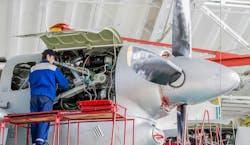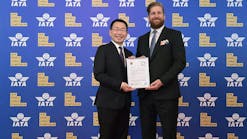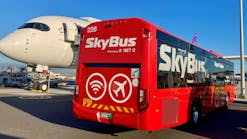Fall Protection Solutions for Ground Support and Aircraft Maintenance Operations
Ground support operations and aircraft maintenance tasks pose unique challenges for technicians and personnel. The Occupational Safety and Health Administration (OSHA) requires fall protection to be used anytime a worker is 4 feet or more above the ground, or the next lower walking working surface.
While repairs and maintenance are important for the safety of pilots and their passengers, the safety of the worker performing the repairs is also important. Falls from heights continue to be a leading cause of occupational injuries and fatalities, so vigilance on this issue is paramount for workers who spend most of their time at heights.
Overhead Anchorage for Ground Support Operations
Outdoor maintenance or ground support work can prove difficult to provide fall protection due to the dynamic nature of the work.
Fortunately, there are many mobile fall protection solutions available that can be deployed to provide overhead anchor options for workers. Systems like rigid rail truss systems, mobile davit arms or counterweight jib anchors are some examples of potential solutions. Overhead anchorage solutions can allow workers to perform their regular work while connecting them into a personal fall protection system should they happen to slip, trip or fall. These solutions will require additional time to mobilize, erect and place in optimum position, but the work is worth the effort if it avoids someone suffering from an accidental fall.
In other instances, bodywork needs on an aircraft might require the use of an elevated platform to access where work will be performed. Mobile elevated work platforms (MEWPs) can help provide an elevated platform for workers with the ability to get the worker exactly where they need to be to successfully perform their task.
Overhead anchorage systems will always be the superior method of protecting workers at heights as they allow for increased mobility and safety factors for users. Unfortunately, most facilities are designed without integrated anchor systems and that’s why ladders or MEWPs are commonly used in maintenance facilities, hangars and other similar environments. But just like any other piece of equipment, improper use or negligence to personal safety can prove disastrous for the operators. If MEWPs are to be utilized, let’s explore the fall protection requirements for various pieces of equipment.
Non-Articulating Lifts
Is fall protection required on non-articulating lifts (also known as scissor lifts)? Here’s the answer nobody likes to hear: it depends.
While federal OSHA code does not explicitly require fall protection in scissor lifts, OSHA does require users to follow manufacturer instructions when operating equipment. Nowadays, almost all scissor lifts have at least one certified anchor integrated into the side rails on the lift. They often even include a small label with a graphic showing a worker in a harness and indicating their tie-off point. If the instruction manual states that a user must use the anchorage when operating the lift, many safety professionals believe connecting a personal fall protection system is now mandated. Cal/OSHA (California’s state-run OSHA program) goes even further and mandates that if a scissor lift contains an integrated anchorage, the user must be tied off to it when operating the lift.
Please note that it is never recommended to attach a personal fall protection system directly to the guardrails integrated on an MEWP. Integrated anchor points are rated for 5,000 pounds (or at least 3,600 pounds, depending on the engineered certification process), but guardrails are only rated for 250 pounds of force on the top rail and 150 pounds of force on the midrails. Attaching a lanyard or self-retracting lifeline (SRL) to one of these rails would not provide adequate anchor strength and the system is likely to fail.
Articulating Lifts
When it comes to articulating lifts (also known as boom lifts), matters are more cut and dry. Federal OSHA states that users must use fall protection equipment on articulating lifts, as the risk of being ejected from the platform is significantly greater than non-articulating lifts. However, OSHA does not clarify if fall prevention or fall arrest is required, so it is up to the employer to decide which method to pursue. The Army Corps of Engineers EM385 standard (that applies to most federal government properties) further clarifies that travel restraint methods must be used; fall arrest equipment is not allowed.
Fall Prevention versus Fall Arrest
Fall prevention is defined as using equipment that restricts the movement of a worker, so they are not subject to a fall, typically utilizing a fixed-length lanyard. If properly specified, the user would be issued a lanyard that is long enough to allow them to walk around their working platform but short enough to not allow them to exit the basket while connected to their anchorage. These systems work excellently, in theory, but actual field usage typically produces mixed results.
Since platform sizes can vary and many pieces of equipment might be used, calculating the exact working distance from the anchor point can be difficult for safety professionals. They often end up issuing adjustable length non-shock absorbing lanyards to users. It is then up to the user to constantly tension the device to a short enough length that allows them to work productively but restricts their option to travel too far and be subject to falling out of the basket. If the worker neglects to tension the device and is then subject to a fall, their non-shock absorbing lanyard has no means of absorbing fall forces or decelerating their fall. They would feel extreme fall forces to the body that would certainly cause injury and could potentially prove fatal to the worker, depending on their general health or well-being. Humans can generate up to 1,000 pounds of force per foot of freefall. Not to mention that additional forces from coming in contact with nearby equipment or the MEWP itself would be felt by the user.
Fall arrest equipment contains shock-absorption and deceleration elements that prevent the user from feeling all of the forces that naturally occur after a fall. When a worker is using fall arrest equipment, the risk of falling still exists, but there are substantial mitigation methods to ensure the worker feels as little force as possible. In fact, the American National Standard Institute (ANSI) Z359 standard requires manufacturers to guarantee that a fall arrest user will be subject to no more than 1,800 pounds of force if the equipment is being used properly.
Rescue Planning
The use of fall arrest equipment in any application also requires a fall rescue plan, per OSHA. While 911 should be called anytime somebody falls, even if their fall is successfully arrested, an employer must have means to self-rescue the worker. Rescue plans can vary from simple to complicated and they must provide the worker with a means to safely disconnect from their fall protection equipment and be medically evaluated for further injuries. OSHA requires fall victims to be rescued within 15 minutes of a fall occurring.
No matter the chosen rescue method, it is important to prepare for the circumstance that the user is unconscious and cannot assist in their own rescue. Rescue plans should be incorporated into regular fall protection training given to authorized users. Additionally, rescue procedures should be reviewed each time a worker dons fall arrest gear to make sure the rescue equipment is readily available and in good working condition. Rescuers should be standing by while work at heights is being performed to ensure a prompt and successful rescue.
Conclusion
If your facility exclusively uses ladders or MEWPs to perform work at heights and has experienced challenges or injuries in the past, perhaps it is time to evaluate whether an overhead anchorage system would prove beneficial. Companies like Diversified Fall Protection are experienced in retrofitting buildings to incorporate overhead anchor solutions, as well as engineering and designing unique solutions for unique applications. Regardless of the fall protection methods chosen, be sure to empower workers by training frequently and incorporating their feedback to constantly improve the safety of their work environment.
Philip Jacklin is the continuing education program manager for Diversified Fall Protection. Since 2018, Jacklin has been training workers nationwide on best practices when using their fall protection, and advising safety managers, EHS (environment, health and safety) leaders, plant maintenance managers and other safety professionals on how to create more efficient fall protection programs.







